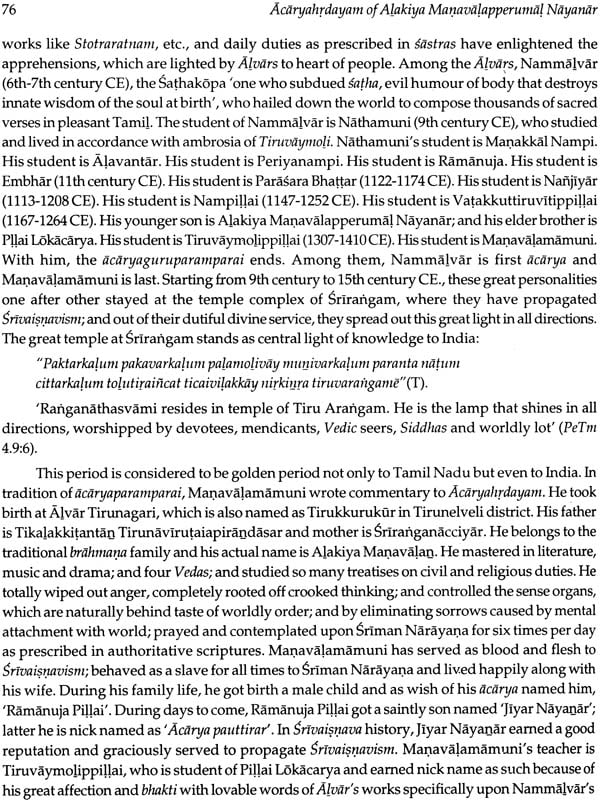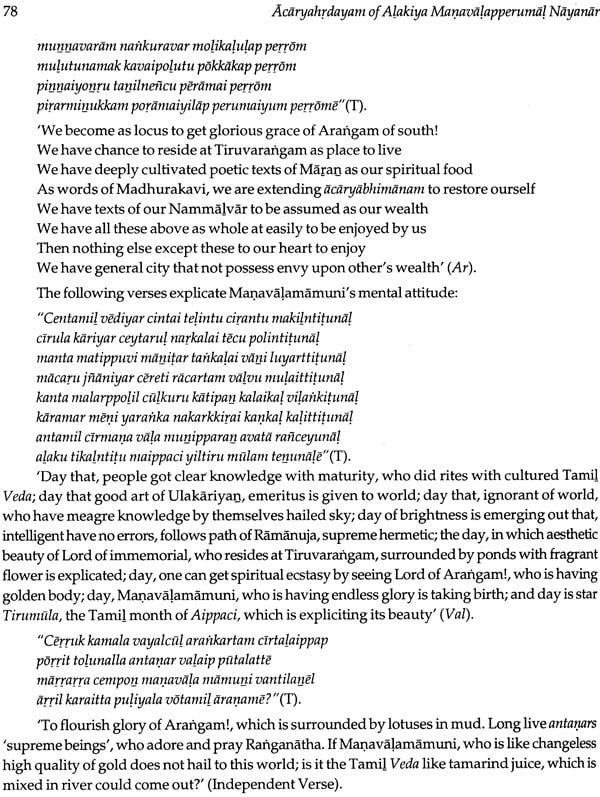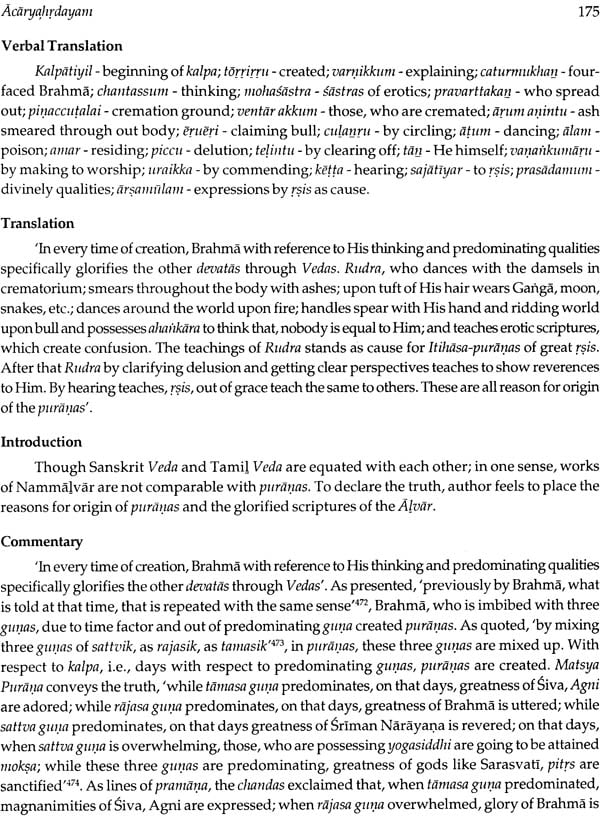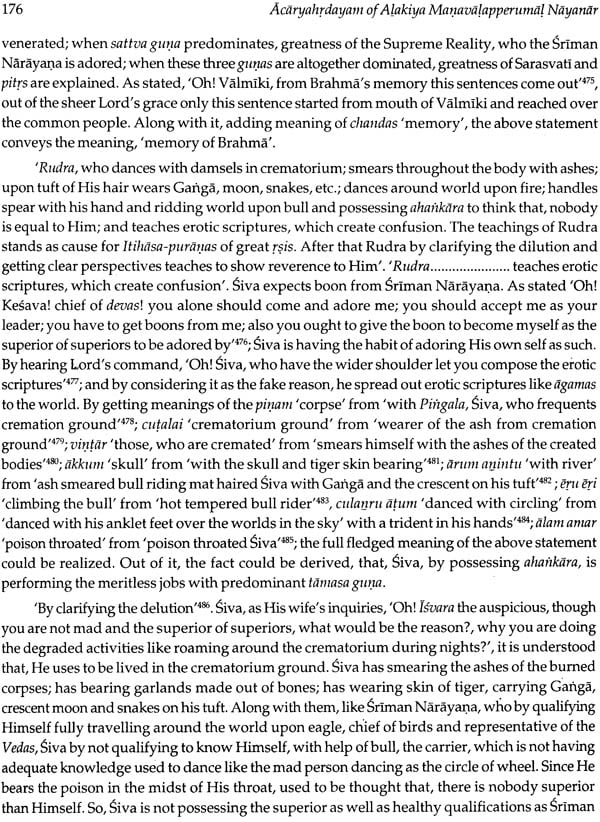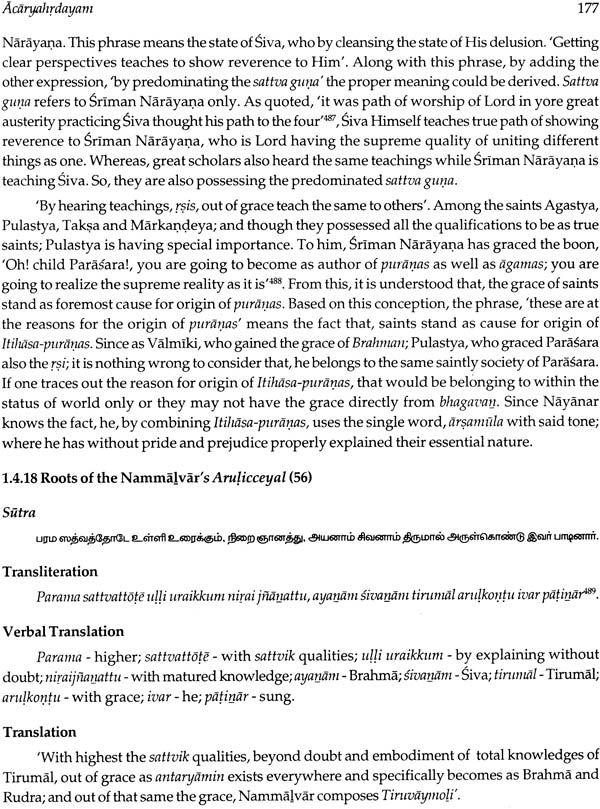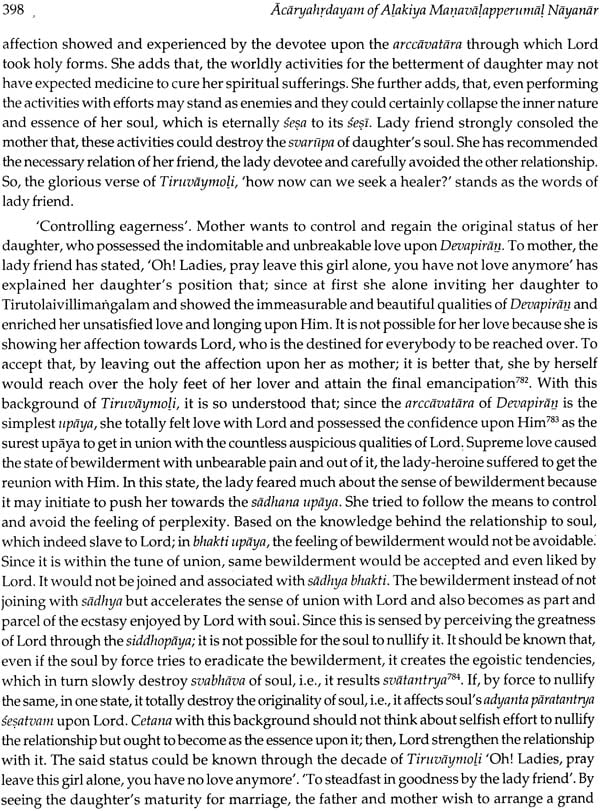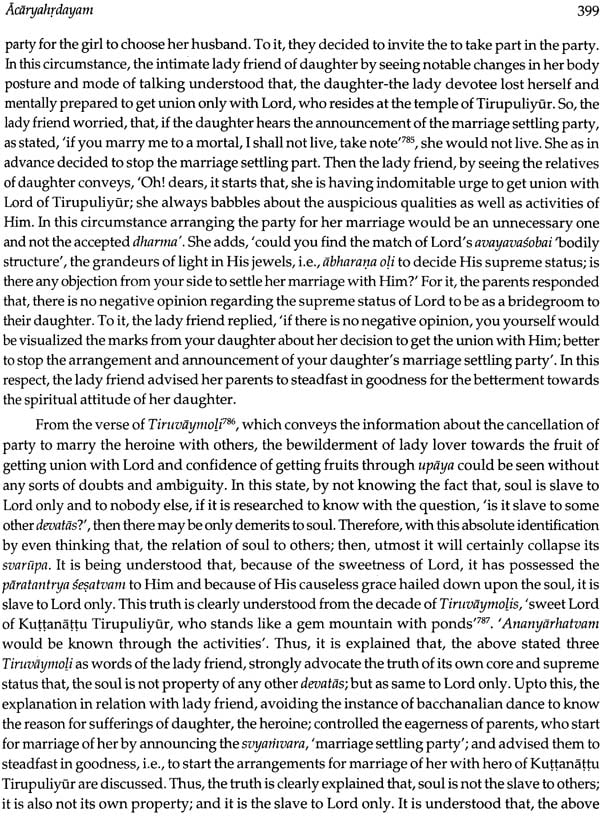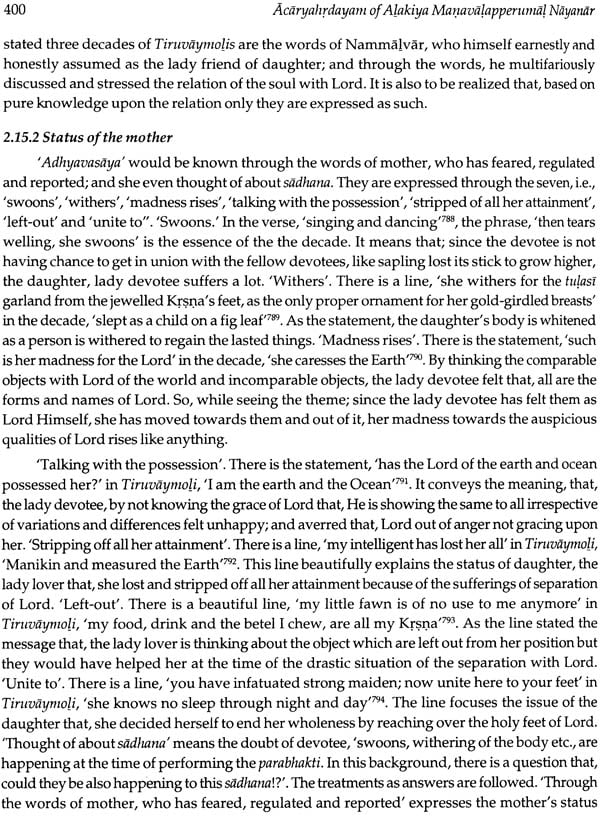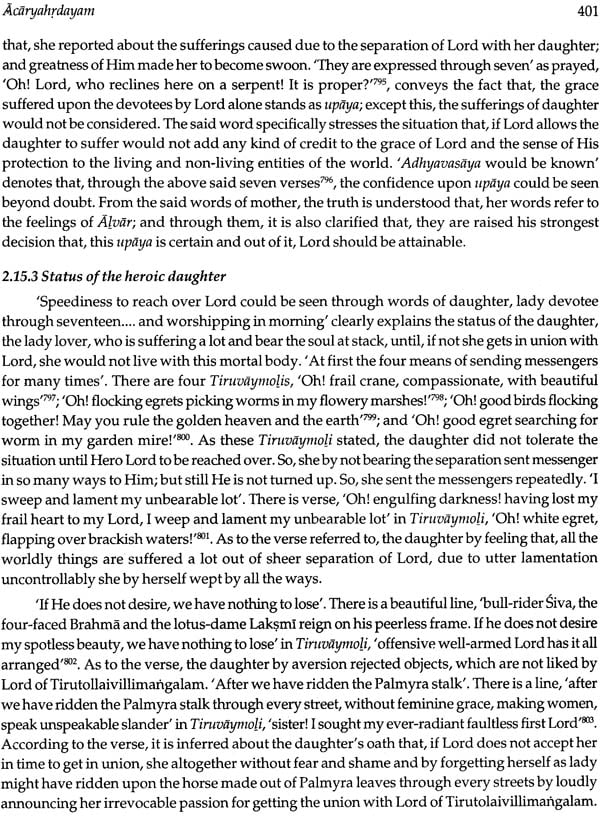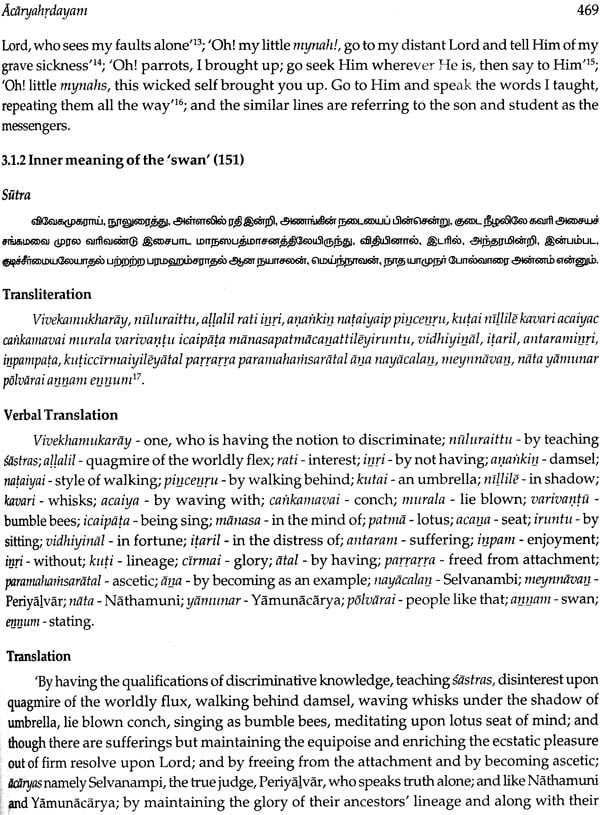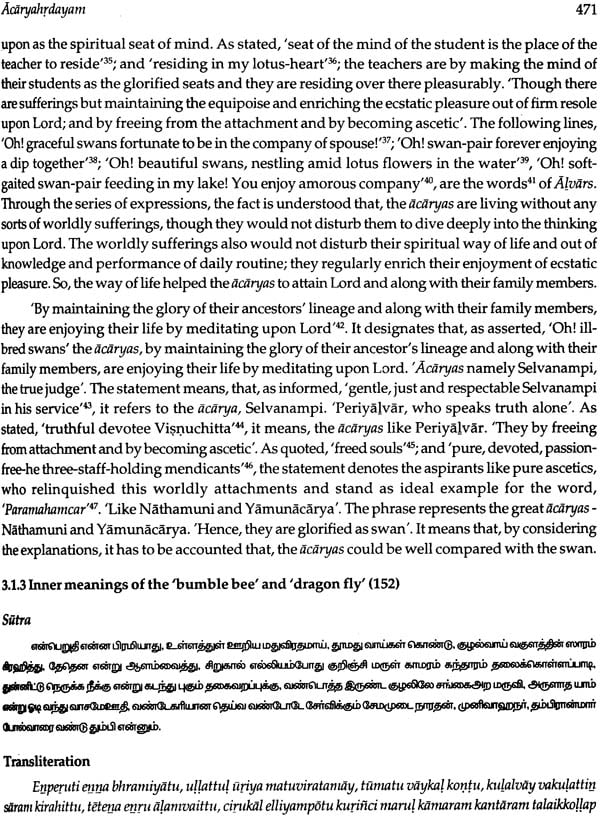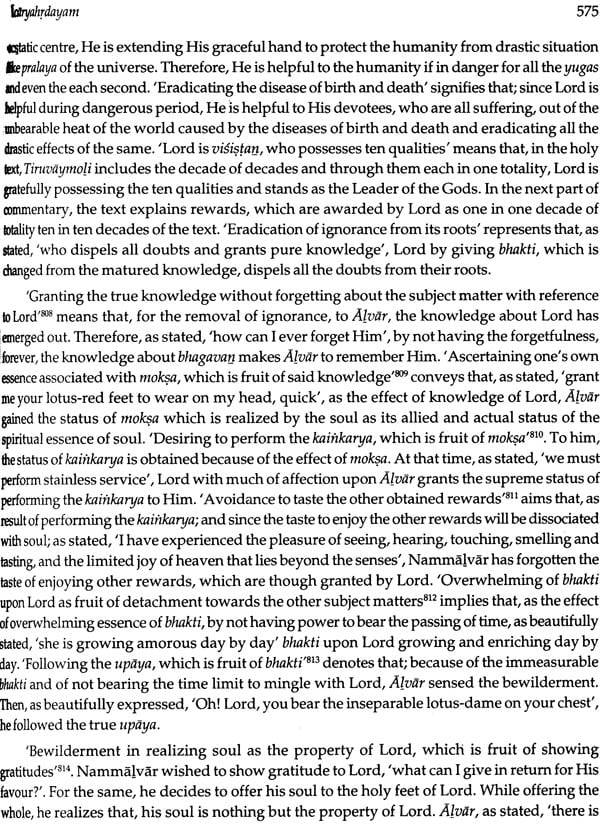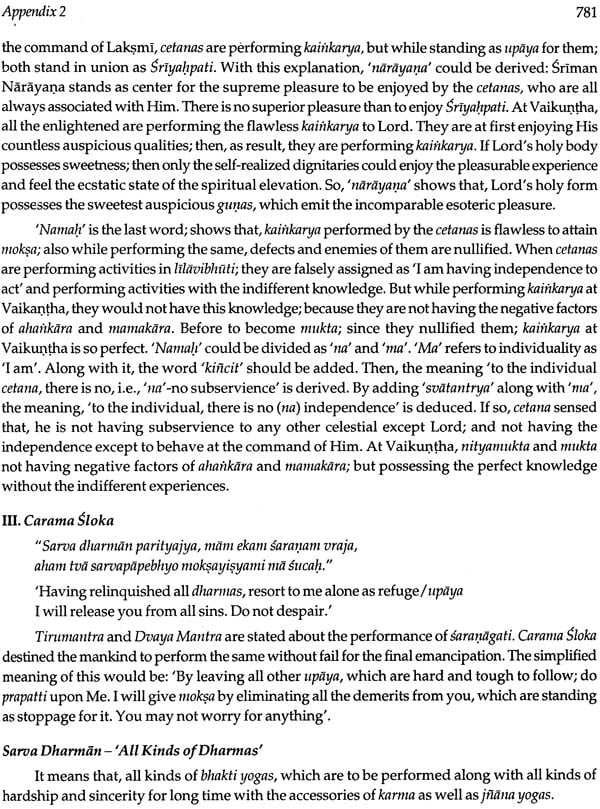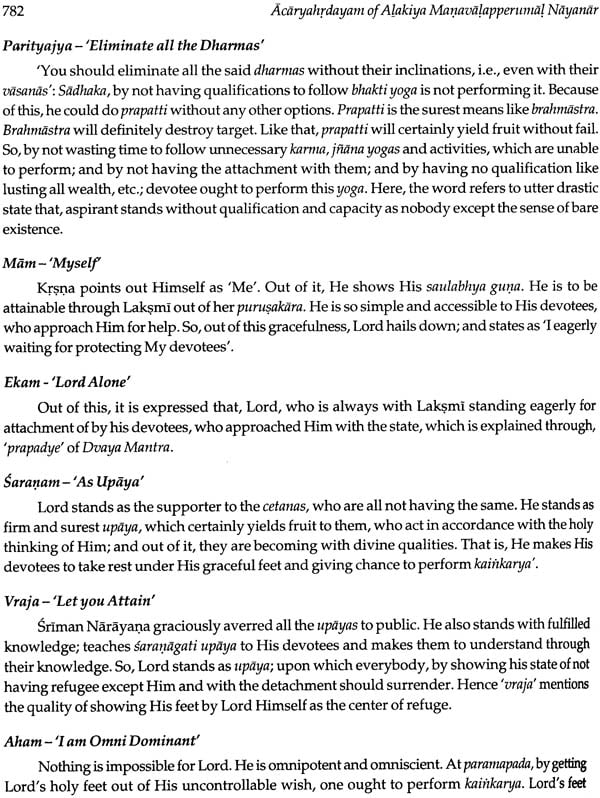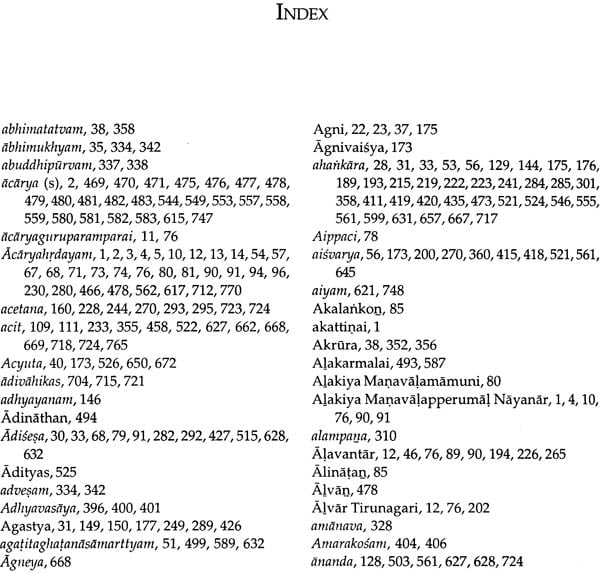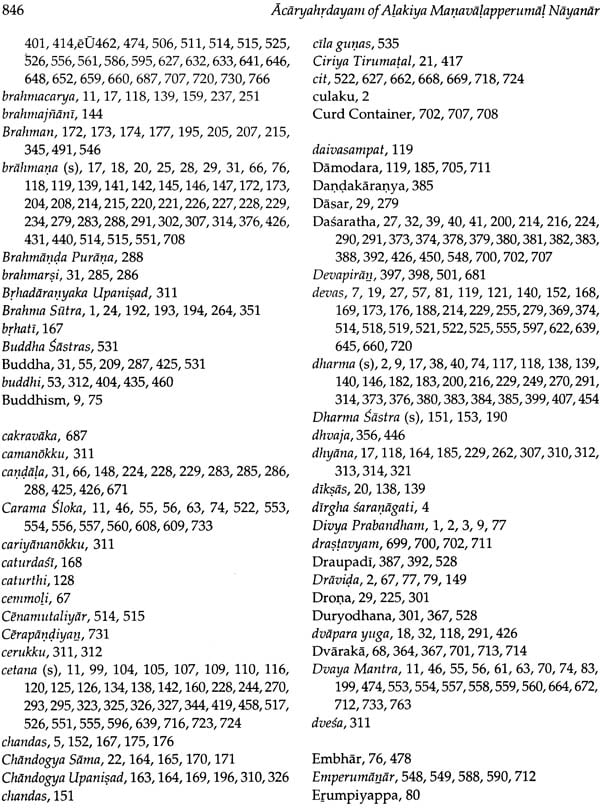
Acaryahrdayam of Alakiya Manavalapperumal Nayanar (Translation and Commentary of Manavalamamuni: Theology of Nammalvar in Post-Ramanuja Srivaisnavism) (Set of 2 Volumes)
Book Specification
| Item Code: | NAJ671 |
| Author: | J. Rangaswami |
| Publisher: | Sharada Publishing House |
| Language: | Tamil Text with Transliteration and English Translation |
| Edition: | 2015 |
| ISBN: | 9788192698397 |
| Pages: | 1390 (12 Color Illustrations) |
| Cover: | Hardcover |
| Other Details | 11.0 inch x 8.5 inch |
| Weight | 3 kg |
Book Description
J. Rangaswami, Professor and Chairperson, School of Philosophy and Dean, Faculty of Languages, Tamil University is rank holder in M.A. (1980), M.Phil. (1981) in Philosophy, and Ph.D. (1985) on Bhagavadgita at the Department of Philosophy, AnnamalaiUniversity. He obtained M.A., Sanskrit (2013) and Diploma in Astrology (2012) at SASTRA University. He has completed 14 Research Projects and credited with UGC Research Associateship in the Department of Philosophy and Religion, Banaras Hindu University (1994- 96) and Indian Institute of Advanced Study (1996-98). As an acknowledgement for his outstanding erudition, Madras University honoured him with a D.Litt. (2012) for his magnum opus, Srivacanabnusanum. He has published 9 books, 50 articles, delivered 50 special lectures and presented papers to 95 national and international conferences. He completed thisAcaryahrdayam under the scheme of Major Research Project (2004-2007), financed by UGC. He is a Commonwealth Fellow (2004) at Lancaster University, UK and delivered special lectures at various scholarly institutions of England. He also participated in the 2nd International 'Ayurveda and Yoga Conference' at Sidney on 2009; and delivered special lectures at 'Dharma Heart Yoga and Meditation Centre', Australia.
His modern erudition on Srivaisnanism with Western perspectives remarkably has cut across the boundaries of multi- cultural and religious legacies of the world.
The glorified spiritual and intellectual properties of India in religious, sociological and traditional sectors along with Sanghamliterature; Canonical texts of Alvars and Nayanmars; and reverential writings of Acaryas of Saivism and Vaisnaoism have to be safeguarded and placed before the world intellectual community. Acaryahrdayam, the esoteric treatise of AlakiyaManavalapperumal Nayanar has kept in its contents, noble concepts of medieval Tamils and their lofty ideals. Also comes in a lot of references about the mode of living, oral traditions and cultural customs and the habits of indigenous Tamils. This polemical text was composed to protect the cult of Vaisnavism in all its perspectives in India.
Right from the 13th century CE, there has been a distinct literary genre known as manippravala style of blending of the prose of both the Tamil and Sanskrit languages. Though this prose format is subjected to criticism, devout Yaisnava scholars relish it as a balanced admixture of both the scripts. It is further to be remembered that, hymns of Nalayira Divya Prabandham have been commented on similarity in this prose style. One of the points highlighted in this Acaryahrdayam, the magnum opus is that, apart from appreciating its many-sided values, it asserts that, Nammalvar's Tiruvaymoli need not be set aside. The Alvar being fourthvarni, some of the points that, his holy book contains are reformative perceptions far more advanced than the ideals of even the 20th century Social Reformers. On the basis of certain reasons, Nayanar points out that, Tiruvaymoli- cannot and need not be relegated simply because it is composed in Tamil. In his opinion, this thematic source should be contemplated as an exalted one and far better than even Veda, Bhagavad Gita, Valmiki Ramayana, Mahabharata, etc. Nammalvar is as much reputed as Rama, Kannapiran,Sitapiratti etc. In certain contexts, the Alvar goes far beyond these illustrious personages. All these made it clear that, how farNayanar has -acaryabhakti towards Nammalvar and a devotion to his piety.
The in-depth notion of Acaryahrdayam and its embraced spiritual and theological thoughts such as nirketuka krpa, paratantryasesatva, siddhopaya, sesa-sesibhava, svarupayathatmaya, etc., deserve a wider understanding regionally, nationally and internationally. In addition to what Dr. J. Rangaswami has said in this studious attempt, a further study in comparative approach with themes of other religions may as well be made to make the world realize the ultimate commonalities of life force and an essential unity of existence. It could be an important tool of reorienting a cosmopolitan culture within the societal context of scientific advancement and modem era of materialism.
It is highly commendable that, Dr. J. Rangaswami has deeply studied and indefatigably analyzed the whole volume of original with English Translation, Transliteration and a detailed erudite exegesis. His academic attempt with its exhaustive comment may be highly recommended for appreciation of scholars and public of Vaisnva sect. Even those, who are not aware of anything about this text, will certainly be enlightened by a scholastic glance of this learned commentary.
Though Acaryahrdayam is embedded in manippravala style, that remains inaccessible even to mediocre, Dr. J. Rangaswami has gone into depth and rendered it into lucid English. His hard work and assiduous labour in bringing out this commentary is highly appreciable. His speculative comments and innate intuitiveness are thoroughly understandable. He believes that, this will satisfy the taste and thirst of Vaisnava and theological scholars of the whole world.
I deeply appreciate his academic venture and intellectual versatility and wish him to contribute many more volumes of critical writings.
Acaryahrdayam in manippravala style is effectively translated with aesthetic value into English and without loosening the religious charm by means of finely tuned linguistic equivalences. It bridges the religious understanding of Tamil and Western Countries that includes all those who are conversant in English. In it, transference is maintained to explicate the originality through the grammatical, syntactical and idiomatic forms. After acquiring the in-depth knowledge and excellent command; and by gaining familiarities within the Srivaisnavism; and with the profound experiences of precised etymological and idiomatic expressions; the author of this work with much stress has efficiently attempted for maximum perfection.
A translator should be competent in word-to-word translation, grammatical structures like idioms, vocabulary, etc. The author through his academic endeavours, by acquiring possible apprehension, training and experiences, successfully completed this monumental task with the first-hand support of the computer-assisted translation including the standard dictionaries without diluting the religious tempo. Since the terms, phrases and verses, those involve the domain of mind and with the emotional and sentimental categories behind the age-old societal habits of cultural adherence; it is this restraint that prevents me to claim the cent percent success of the translation of Srivaisnavism. Therefore, to guide and facilitate the readers, conceptualistic notions behind the religious experiences are literally explained. These two volumes may not be excelling in explicating the originality, but certainly pave the ways to realize the sense of merging soul with divineness. Throughout the process, 'functional equivalence' or 'meaning based translation' is appropriately carried out, where the most precise meanings are lexically translated and the linguistic intricacies are taken care of. The present author exercised his talent in the English rendition of original sayings, where he has gone further and the interpretations are based upon the pre-emptive appreciation of the readers. Anyhow, the linguistic style of Acaryahrdayam isrhythmic and its sound, while orderly pronounciation may produce spiritual vibrations, while is spiritually piquant. If one repeatedly murmurs the lines, mystically his concentration could centripetally focus upon the blissfully enlightened state. Hence this author, though exercised the all possible attempts to express the regional sensitivity in English, he could not achieve what h intently feels, because the nativity and local import of particular linguistic structure could not b exposed as such. Reader could have sensed the more religiousness through this studious world for which, the translator contemplates that, he may not responsibly be succeeded in his attempt.
Translation of a canonical text within the Interlingua communication is sociolinguistic complex, because the form, beliefs, faiths and indigenous values have transformed through the religious history. Also, the differences in-between the original and present day interpretations schismatic differences; changed usages and altered versions are playing a major role. Apart from this, the new ideological complexities with respect to the national and international societal changes, renewed insights upon the meanings of the ancient texts and constant changes of modern languages hamper the perfectness of the canonical text besides making us to think whether it will ever be possible. However, this cosmopolitan translation could serve the purpose, because this author seriously viewed all these considerations. It is of his indomitable faith that, this will as a seed of fig tree, certainly helps for future translations.
The book, at first provides an extensive 'Introductory Thesis'. If a reader possesses the academic background, this will facilitate to realize even the subtle concepts, which are being extensively dealt throughout this work. Then, by relying upon the authentic remarks given by Pandita Vidvan B. R. Purushothama Naidu (2001), the educated scholar of Srivaisnavism, the short notes onAlakiya Manavala Perumal Nayanar and Manavalamamuni along with their family background are shortly discussed. Then, the translations of Taniyans are carried out, which precisely explain the greatness of Nayanar's clan and his authoritativeness. Following this, a sharp translation of Uraippayiram (Preface) written by the Commentator himself is placed. In the main part of each unit, after the aphorism, there is 'Transliteration', where international acceptable phonetic style is utilized. Then, 'Verbal Translation', is exercised. Afterward 'Translation' of each aphorism is elucidated. In it, without changing and altering, a constructive exposition of the originality of sutra is placed out. Then, in 'Introduction', there is preliminary note, which appropriately directs the reader to enter into Commentary part. Translator, by having familiarity, suitably placed the words, phrases and sentences of translated aphorism and added the expanded commentary part for them. Based on the modes of presentation of a single or unified set of sutras dealing with particular concept, the entire book is academically classified with suitable titles and subtitles. Necessarily if a particular sutraor an entire part (IV) needs the both, the commentary is titled with the same for the free flow of understanding. At the end o each major part, references are suitably placed, where to follow the continuity of subject, needful remarks are incorporated. First three appendixes are helpful to have the necessary background of the Text. First one touches that, how Nammalvar has expandedTiruvaymoli, which is rooted from Tiruvaymoli. In the second, the implied and intended meanings of the three Rahasya Mantras are accurately discussed. Third, the hagiological chart expressed the chronology of acaryaguruparamaparai, which shows about the periods of acaryas and their valuable contributions to the development of this religion through the ages. The fourth appendix provides the alphabetic order of the sutras (Tamil), volume and page number; through which One could strait away easily peruse the discussions of the specific sutra. Then, glossary provides the basic meanings of technical words. This part would not representMonier-Williams' (1974) 'A Sanskrit-English Dictionary' or Chidambaranatha Chettiar's (1992) 'English-Tamil Dictionary' orFabricius' (1972) 'Tamil and English Dictionary' or "Tamil Lexicon' (1982) of University of Madras; but sincerely supplies the limited textual meanings, which give the essential knowledge to proceed the discussions of the main text. After that, a completely inclusive bibliography is added, where full- fledged primary sources of Tamil/Manippravala with their English Translation; wide-range of Dictionaries, Glossaries and Lexicons, which help for perfect translation; and the secondary resources covering the extensive array of sources related with the obscure subject matters along with the necessary articles utilized for sharp presentation are viably placed, It, as the compressed intellectual velocity may help the readers to enrich their in-depth erudite scholarship within the Srivasnava epistemology and metaphysics in relation with societal context of noumenal as well as phenomenal emancipations. Lastly, an index for cross-references is added.
I am indebted to Sri U. Ve. Dr. S. Kotandaraman Swami, Professor Emeritus, Department of Sanskrit, Raja's College, Tiruvaiyaru.Whenever I had the ideological dormancy and psychophysical tiresome on writing the manuscript; he as my Guru of Vaisnava order, has empathetically rectified the same. As senior friend, he as oasis has boosted me to complete this English rendition with appropriate words to protect the indigenousness of religiosity without deviating from the originals; and safeguarded me not to dwell into wrong perception and misapprehension. Although there are no words, but I felt comfortable because without his help, the book may not possess the classical galore and modernity, My heart slackens and tears soaked and ooze out. Though orthodox but every inch modem, who is Sri. U. Ve. Prof. Dr. T. N. Aravamudhan Swami, Principal, Raja's College. If he would have not opened his gracious sight upon me, I would have missed the greatest opportunities to interact with the seeded intellectuals of Srivaisnava fold. From whom, I have learned many concealed treasures of the order and realized the essential meanings of nitya-naimitya karmasalong with performing kainkarya upon Sriman Narayana. By remembering his smiling face and blooming eyes, I am immensely submitting my profound regards. I am also obliged to Sri. U. Ve. Dr. S. Lakshmikumar and Sri. U. Ve. Dr. V. Raman, Lecturers, Department of Sanskrit, Raja's College, who have assiduously co-ordinated and traced out the main sources of all quotes with their meanings. I should not forget them without expressing my thanks; but immensely believe that, they are always with me.
| Felicitation | v | |
| Foreword | vii | |
| Blessings | ix | |
| Preface | xxi | |
| Notes Regarding Transliteration | xxvii | |
| Abbreviations | xxix | |
| Introductory Thesis | 1-93 | |
| 1. PART-1 (Sutras 1-86) | ||
| 1.1 | Purpose of the Veda, Itihasa and Puranas (Sutras 1-15) | 97-113 |
| 1.2 | Differences between the Sastras and Tirumantra (Sutras 16-35) | 116-143 |
| 1.3 | Differences between the Brahmanas and Srivaisnavas (Sutras 36-38) | 144-147 |
| 1.4 | Differences of Nammalvar's Prabandhams and the Sanskrit Vedas (Sutras 39-56) | 148-177 |
| 1.5 | Superiority of Nammalvar (Sutras 57-62) | 178-188 |
| 1.6 | Greatness of Tiruvaymoli (Sutras 63-78) | 189-210 |
| 1.7 | Glory of Nammalvar's birth place, sudra caste and his clan (Sutras 79-84) | 212-218 |
| 1.8 | Greatness of Nammalvar with significance of the bhagavatas (Sutra 85) | 220-227 |
| 1.9 | Without the bhakti, varna, status, knowledge, etc., are degraded (Sutra 86) | 227 |
| 2. PART- 2 (Sutras 87-149) | ||
| 2.1 | Birth of servitudes to Sriman Narayana is the best (Sutras 87-90) | 281-286 |
| 2.2 | Greatness of Nammalvar (Sutras 91-93) | 288-292 |
| 2.3 | Sriman Narayana's grace upon the avatara of Nammalvar (Sutras 94-98) | 296-303 |
| 2.4 | Demonstrating the sadhana bhakti (99) | 306-314 |
| 2.5 | Greatness of Nammalvar's bhakti (Sutras 100-103) | 316-321 |
| 2.6 | Nammalvar's bhakti is the outcome of grace of Lord (104) | 321-329 |
| 2.7 | Ascertaining that, Lord's grace is the cause for Nammalvar's bhakti (Sutras 105-114) | 329-343 |
| 2.8 | Nammalvar is Parankusa Nayaki to Sriman Narayana (Sutras 115-121) | 344-350 |
| 2.9 | Lady speech of Nammalvar is not the derived one (121) | 351-356 |
| 2.1 | Nammalvar is compared with the devotees of Lord (Sutras 122-131) | 356-371 |
| 2.11 | Nammalvar is further equated with other devotees of Sriman Narayana (127) | 372-381 |
| 2.12 | Narnmalvar is superior to all the others (Sutras 128-131) | 382-388 |
| 2.13 | Nammalvars bhakti is boundary-less (Sutra 132) | 389 |
| 2.14 | Amatory subject matter of lady friend, lady lover and mother (Sutra 133) | 393 |
| 2.15 | Nammalvars triple conditions are expressed in Tiruvaymoli (Sutra 134) | 395-401 |
| 2.16 | Plurality of mentioning as the lady friends and mothers (135) | 403 |
| 2.17 | Inner meaning of seven stages of Parankusa Nayaki of Nammalvar ( 136) | 404 |
| 2.18 | Inner meaning of praising heroine's parts of the body (137) | 405 |
| 2.19 | Variations in the activities of lady friend, mother and heroine (138) | 408 |
| 2.2 | Relatives and enemies to the mother, daughter and lady friend (139) | 412 |
| 2.21 | Inner meanings of the matters compared with Nammalvar (Sturas 140-149) | 413 |
| 3. PART - 3 (Sutras 150-218) | ||
| 3.1 | Inner meanings of the messenger birds (Sutras 150-155) | 467-481 |
| 3.2 | Demonstrating the subject matters for the four kinds of messages (Sutra 156) | 484 |
| 3.3 | Except the differences in statuses; there is no difference in attainment (Sutra 157) | 487 |
| 3.4 | Reasons for the attraction of Nammalvar towards arccai (Sutra 158) | 489 |
| 3.5 | Explication of the specific quality to each holy city (Sutras 159-186) | 490-517 |
| 3.6 | Time, qualification of authority and sweetness of Tiruvaymoli (Sutras 187 and 188) | 518-519 |
| 3.7 | Tiruvaymoli is equated with Bhagavad Gita (Sutra 189) | 521 |
| 3.8 | Tiruvaymoli is superior to Bhagavad Gita (Sutras 190-194) | 527-530 |
| 3.9 | Nammalvars teachings for the all (Sutras 195 and 196) | 531-533 |
| 3.1 | Specialty of subject matter to teach the four kinds of people (Sutra 197) | 534 |
| 3.11 | Alvar teaches many times to ordinary devotees and even to Lord (Sutra 198) | 536 |
| 3.12 | Teachings to Lord because of bhakti; to the people because of jnana (Sutra 199) | 540 |
| 3.13 | Rare quality of not bearing the sufferings of others (Sutras 200 and 201) | 541-542 |
| 3.14 | Lord as student is the follower of Nammalvar (Sutra 202) | 542 |
| 3.15 | Reasons for Nammalvar to teach the samsaris (Sutra 203) | 545 |
| 3.16 | Nammalvar with Sita, Prahlada, Vibhisana and Ramanuja (Sutra 204) | 547 |
| 3.17 | Fruits of the teaching people, who without bhakti (Sutra 205) | 549 |
| 3.18 | Asserting the causeless grace of Nammalvar (Sutra 206) | 551 |
| 3.19 | Though Nammalvar teaches, his spirituality is uninterrupted (Sutra 207) | 552 |
| 3.2 | Nammalvar's Prabandhams are the explication of three rahasyas (Sutra 208) | 553 |
| 3.21 | Nammalvar's Prabandhams are the specification of three mantras (Sutra 209) | 554 |
| 3.22 | Tiruvaymoli is the commentary of Dvayam (Sutra 210) | 557 |
| 3.23 | Tiruvaymoli stands as the sole refuge for the devotees (Sutra 211) | 559 |
| 3.24 | First verses of Tiruvayamoli and Tiruvayamoli are the summary (Sutra 212) | 563 |
| 3.25 | Praise; adoration and fore-telling are the truths of Tiruvayamoli (Sutra 213) | 566 |
| 3.26 | Tiruvaymoli is in the form of decade of decades (Sutra 214) | 567 |
| 3.27 | Tiruvaymoli is the inner explication of Nammalvar's heart (Sutra 215) | 569 |
| 3.28 | One verse for each decade; and one decade for each centum (Sutra 216) | 570 |
| 3.29 | Aim and scope of Tiruvaymoli (Sutra 217) | 571 |
| 3.3 | Ten decades express the Lord's qualities; and the fruits gained (Sutra 218) | 573 |
| 4. PART – 4 (Sutras 219-234) | ||
| 4.1 | Essence of the First Decade of Tiruvaymoli (219) | 619-624 |
| 4.2 | Essence of the Second Decade (Sutra 220) | 627-631 |
| 4.3 | Essence of the Third Decade (Sutra 221) | 635-643 |
| 4.4 | Essence of the Fourth Decade (Sutra 222) | 644-651 |
| 4.5 | Essence of the Fifth Decade (Sutra 223) | 654-658 |
| 4.6 | Essence of the Sixth Decade (Sutra 224) | 661-672 |
| 4.7 | Essence of the Seventh Decade (Sutra 225) | 673-681 |
| 4.8 | Essence of the Eighth Decade (Sutra 226) | 682-689 |
| 4.9 | Essence of the Ninth Decade (Sutra 227) | 690-695 |
| 4.1 | Essence of the Tenth Decade of Tiruvaymoli (Sutra 228) | 698-724 |
| 4.11 | Reason for Lord not to Grant the Moksa immediately (Sutra 229) | 725 |
| 4.12 | Parabhakti, Parajnana and Paramabhakti (Sutras 230-232) | 727-730 |
| 4.13 | Thematic crux of Tiruvaymoli (Sutra 234) | 732 |
| Appendix 1 - Tiruviruttam expanded as Tiruvaymoli | 771 | |
| Appendix 2 - Meaning of three Srivaisnava Rahasyas or Mantras | 777 | |
| Appendix 3 - Historical chart (from Ramanuja to Manavalamamuni) | 785 | |
| Appendix 4 - Alphabetic Order of the Sutras (Tamil) | 787 | |
| Glossary | 795 | |
| Bibliography | 823 | |
| Index | 843 |

